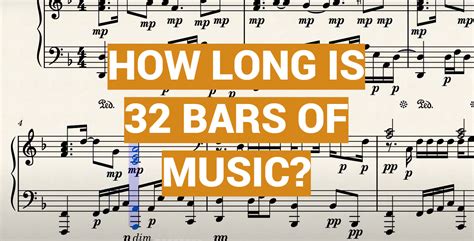The Musical Measure of Time

In music, a bar, also known as a measure, represents a unit of time that establishes the rhythmic structure of a piece. A bar is typically notated with a vertical line drawn through the musical staff, dividing it into equal segments. The length of a bar is determined by the time signature, which specifies the number of beats in each bar and the type of musical note that receives one beat.
Time Signature and Bar Length
Time signatures are typically written as two numbers stacked vertically, with the top number indicating the number of beats per bar and the bottom number representing the type of musical note that receives one beat. For example, a time signature of 4/4 indicates that each bar contains four beats, and each quarter note (crotchet) receives one beat.
32 Bar Length
Given the time signature of 4/4, 32 bars would consist of 32 x 4 = 128 beats. This means that a piece of music written in 4/4 time with 32 bars would have a total duration of 128 beats.
Duration in Different Time Signatures
The duration of 32 bars can vary depending on the time signature used. Here are some examples:
| Time Signature | Number of Beats per Bar | Duration of 32 Bars |
|---|---|---|
| 2/2 | 2 | 64 |
| 2/4 | 2 | 64 |
| 3/4 | 3 | 96 |
| 4/4 | 4 | 128 |
| 6/8 | 6 | 192 |
Calculating Bar Duration
To calculate the duration of 32 bars in a given time signature, simply multiply the number of beats per bar by the number of bars. For example:
- In 4/4 time, 32 bars = 4 beats/bar x 32 bars = 128 beats
- In 6/8 time, 32 bars = 6 beats/bar x 32 bars = 192 beats
Musical Applications
The length of 32 bars is significant in music for several reasons:
- Song Structure: Many popular songs follow a verse-chorus-bridge-verse structure, with each section spanning around 8-16 bars. 32 bars provide a standard length for a complete song.
- Classical Music: In classical music, 32 bars is a common length for movements within sonatas, symphonies, and concertos.
- Jazz and Electronic Music: 32-bar phrases are prevalent in jazz and electronic dance music, forming the basis for chord progressions and improvisational solos.
Conclusion
The length of 32 bars is a fundamental element in music, defining the rhythmic structure and providing a framework for musical compositions. Understanding the relationship between time signature and bar length allows musicians to create and interpret music effectively.
